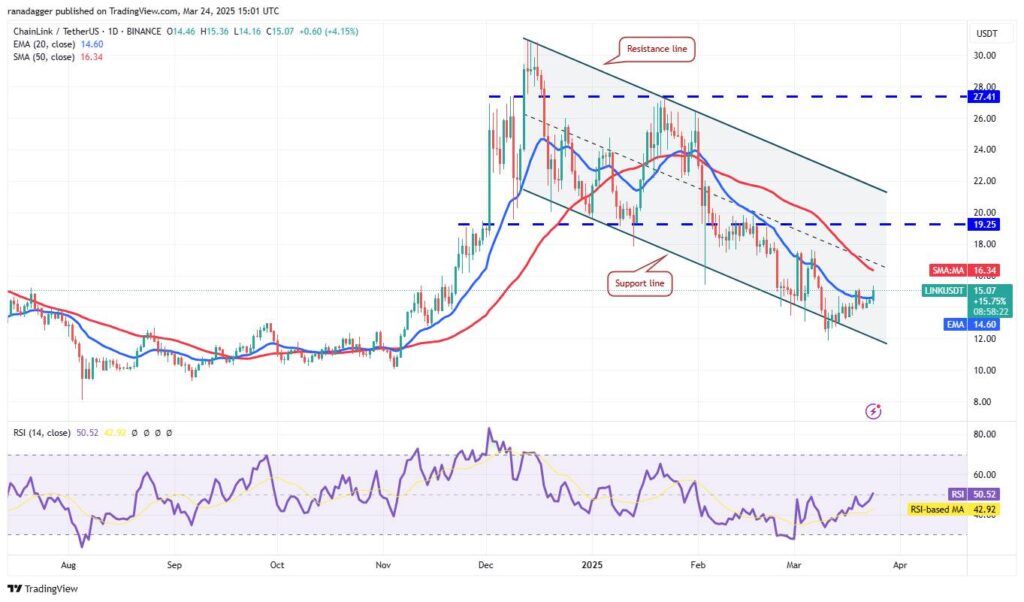Bitcoin (BTC) has made headlines recently, showing a notable recovery last week with an impressive rise of 4.25%, closing above ,000 and peaking above ,700 on March 24. This surge has sparked optimism among many traders, especially following a report from Markus Thielen, founder of 10x Research, which indicated positive reversal indicators for Bitcoin, hinting at a potential “renewed uptrend.” The cryptocurrency markets are seeing increased buyer activity, particularly in U.S. Spot Bitcoin exchange-traded funds (ETFs), which recorded significant net inflows totaling 4.4 million last week—breaking a streak of five consecutive weeks of outflows.
While Bitcoin shows signs of strength, opinions among analysts regarding its near-term trajectory are varied. Some believe that Bitcoin could face substantial resistance around the ,000 mark, potentially leading to a pullback towards ,000. On the other hand, Arthur Hayes, co-founder of BitMEX, remains more bullish, suggesting that Bitcoin might soar to 0,000 before experiencing a dip to about ,500.
The daily cryptocurrency performance analysis reveals that Bitcoin has broken above its 20-day exponential moving average, a positive signal that may indicate further upward momentum. However, should it face resistance at the 50-day simple moving average (around ,290), there could be implications regarding buyer sentiment and possible price corrections. Conversely, if Bitcoin’s price holds steady above key support levels, the possibility of a rally towards ,000, and even 0,000, remains in play.
Meanwhile, other altcoins like Ether and XRP are displaying mixed trends as they grapple with their own support and resistance levels amid Bitcoin’s resurgence. Ether ETFs have not enjoyed the same inflow success as Bitcoin’s, facing their own challenges with outflows. The broader implications of Bitcoin’s actions and the recovery of the cryptocurrency market will continue to be a focal point for traders and analysts alike.
Bitcoin and Cryptocurrency Market Update
This article discusses the recent performance of Bitcoin and other cryptocurrencies, highlighting key indicators that may affect the market and potentially impact readers’ investment strategies.
- Bitcoin’s Recent Growth:
- Bitcoin (BTC) rose 4.25% last week, closing above ,000.
- Bulls extended the recovery above ,700, indicating buyer confidence.
- Positive reversal indicators suggest a potential renewed uptrend for Bitcoin.
- ETF Inflows and Market Sentiment:
- US Spot Bitcoin ETFs saw net inflows of 4.4 million after five weeks of outflows.
- Contrast with Ether ETFs, which experienced ongoing net outflows, highlighting divergence in market interest.
- Price Resistance Levels:
- Analysts predict significant resistance around ,000 for Bitcoin.
- Potential pullback towards ,000 is also suggested if the resistance holds.
- Arthur Hayes forecasts a peak of 0,000 before a drop, suggesting volatility ahead.
- Broader Market Indices:
- The S&P 500 Index is approaching the 20-day EMA, with expected bearish action if it fails to hold above this level.
- The US Dollar Index shows recovery signs, which could influence cryptocurrency valuations.
- Analyses of Other Cryptocurrencies:
- Ethereum (ETH) needs to breach the ,111 level for bullish sentiment; falling below ,750 could signify further downtrends.
- XRP is showing bullish potential; however, it must maintain momentum above .59 to avoid decline.
- BNB and Solana also exhibit signs of recovery, but critical resistance levels must be managed to maintain bullish trends.
This volatility in the cryptocurrency market emphasizes the importance of ongoing research and active monitoring by investors. Understanding these market dynamics can potentially help readers make informed decisions regarding their investments in cryptocurrency.
Bitcoin’s Surge: Analyzing Market Dynamics and Impact
Bitcoin’s recent rise of 4.25% over the past week has reignited trader interest, pushing its price above ,000 and hinting at an impending break into the ,000 range. This upward trend is supported by Markus Thielen’s report indicating positive reversal indicators, providing a competitive edge over other cryptocurrencies like Ethereum, which is currently struggling with sustained outflows in its ETFs. The stark contrast in market momentum places Bitcoin at a significant advantage, capturing the attention of both retail and institutional investors.
In analyzing the market’s response, the net inflows of 4.4 million into U.S. Spot Bitcoin ETFs represent a pivotal moment that showcases confidence from large players in this asset class. This surge in interest could spell trouble for other digital assets, especially Ether, which has suffered from consecutive weeks of capital outflow. As investors gravitate toward Bitcoin, they may overlook alternatives such as Ether, potentially hindering its recovery and leaving it vulnerable to further losses.
Despite Bitcoin’s momentum, analysts are divided regarding its near-term trajectory. Some speculate a hit against resistance around ,000 could lead to a correction, while others, like Arthur Hayes, predict ambitious targets of 0,000. This analytical divergence introduces a sense of volatility that could unsettle less experienced investors who may panic sell if signs of a downturn emerge. Meanwhile, seasoned traders could leverage this volatility for potential profit-making opportunities, highlighting why comprehensive risk assessments are vital for successfully navigating these price fluctuations.
Moreover, broader market influences such as the performance of the S&P 500 and the U.S. Dollar Index play critical roles. For instance, if the S&P 500 bears take over, it could create a ripple effect, influencing Bitcoin negatively. This interconnectedness underscores Bitcoin’s position as a larger player in the market, and any instability in traditional equities could shift investor sentiment away from crypto assets.
In light of these developments, Bitcoin’s recent price actions have positioned it as a beacon of resilience in the cryptocurrency space. It is likely to attract not just retail investors but also institutional support, which could potentially bolster its value further. However, with the looming challenges faced by directly competing altcoins, this creates a precarious balancing act for both Bitcoin’s sustainability and the broader crypto market’s health.

















